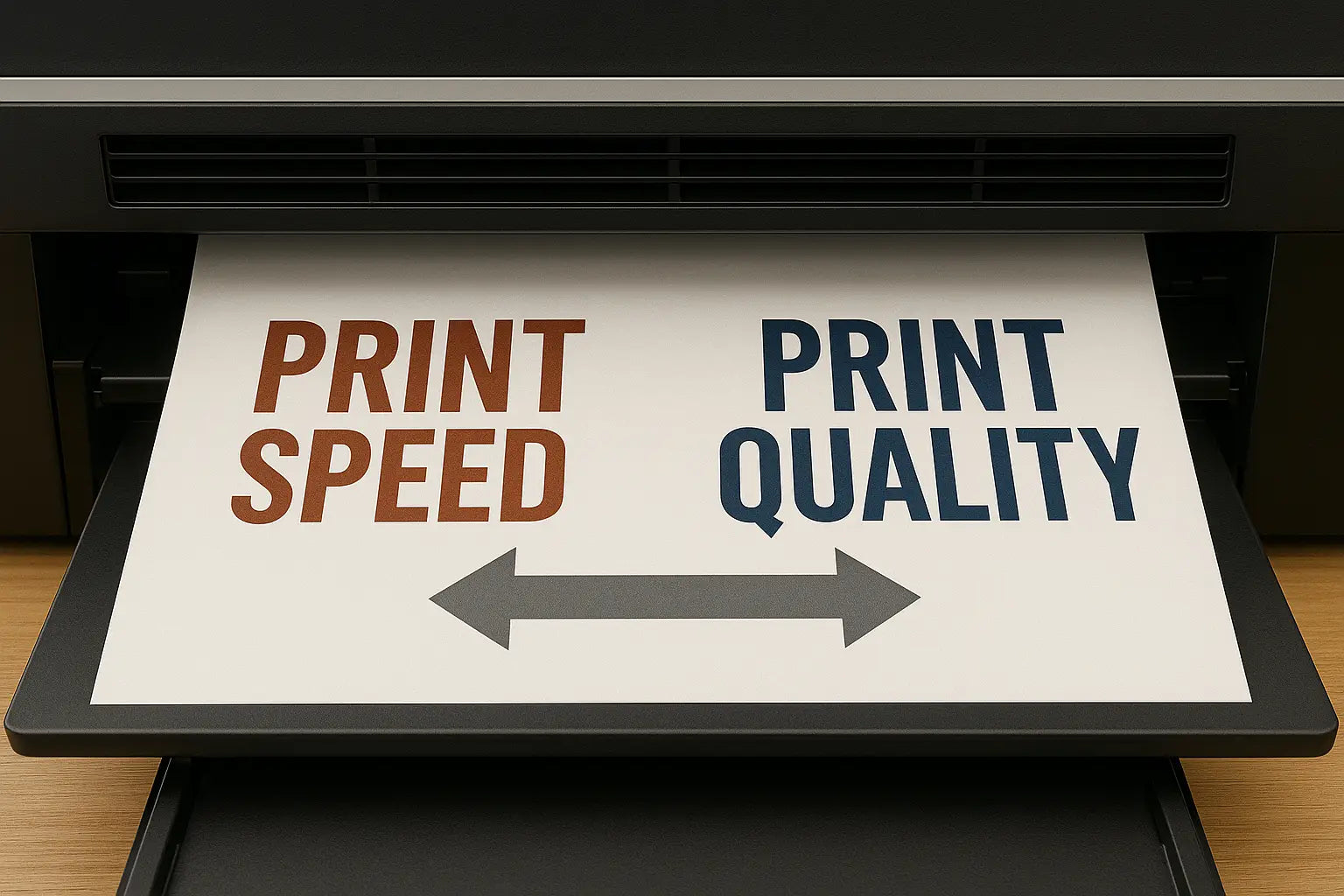In DTF printing, speed and quality go hand in hand. Every printer operator faces this decision, should you print faster to meet orders or slower to get cleaner results? Understanding how DTF printer speed vs quality works helps you find a sweet spot that keeps your prints sharp and your workflow smooth.
Understanding DTF Printer Speed vs Quality
DTF printer speed vs quality means finding the right mix between how fast your machine prints and how detailed your results are. High speed helps with deadlines, while high quality ensures customer satisfaction.
Fast printing can cause light banding or uneven color, while slower printing offers vibrant, crisp designs. The goal is to maintain quality without slowing production too much.
What Affects DTF Print Speed and Quality
-
Resolution and Pass Count: Higher resolution or more passes improve detail but take longer. Fewer passes save time but may reduce color depth.
-
Ink and Film Quality: Poor quality inks or films can slow printing and cause uneven layers. Use trusted brands for consistent output.
-
Printer Model and Settings: Each model handles DTF print speed quality balance differently. Learn your printer’s limits and adjust modes to match design complexity.
-
Temperature and Humidity: Stable conditions improve drying and ink flow. Which supports both speed and quality.
DTF Print Speed vs Quality: Finding the Middle Ground
When managing print speed vs quality DTF printing, start by experimenting. Print one design using three different speed settings and compare results. For simple text or vector art, use faster speeds. For photo prints, go slower to preserve fine detail.
Small tweaks in DTF print speed settings can make a big difference. For example, a 4 pass mode can balance clarity and speed for most apparel designs.
How to Balance Speed and Quality in DTF
-
Use Correct ICC Profiles: ICC profiles help your printer deliver accurate colors even at higher speeds.
-
Keep Printheads Clean: Clean heads prevent ink clogs, ensuring smooth layers and better accuracy.
-
Monitor Ink Levels and Flow: Consistent ink flow avoids faded prints when optimizing for DTF printing speed optimization.
-
Run Test Prints Regularly: Testing helps you understand how small changes affect DTF printer quality settings and results.
-
Adjust Pass Count Wisely: The right DTF pass count vs print time helps you control both color richness and turnaround time.
Throughput and Detail: Finding the Right Ratio
Every business must choose between higher throughput for DTF apparel printing or superior detail. For bulk T shirt runs, prioritize speed. For intricate logos, go slower for accuracy.
Your DTF print resolution vs throughput ratio defines how well you meet client expectations while maintaining efficiency. A good mix ensures you never sacrifice one for the other.
DTF Quality Control Best Practices
-
Check film feed and tension before printing.
-
Use the same environment each day for consistent drying.
-
Update firmware to improve your DTF printer performance comparison.
-
Avoid skipping maintenance schedules. A clean printer runs faster and lasts longer.
By following these DTF quality control best practices, you’ll reduce reprints and deliver perfect results every time.
Tips to Improve DTF Printing Speed Optimization
-
Use high quality powder adhesive that melts evenly.
-
Preheat film slightly to speed up ink bonding.
-
Choose the best curing temperature for each fabric type.
-
Keep your DTF printing speed optimization workflow consistent: same film, inks, and software settings.
This approach helps you get steady prints while keeping production fast.
Trade Off Between Speed and Detail in DTF
There’s always a trade-off between speed and detail in DTF. But balance comes from experience. Know your customer needs: fast bulk jobs or high end detailed prints: and adjust settings accordingly.
A well calibrated machine, clean heads, and reliable materials can give you both quality and efficiency in every run.
Conclusion
Mastering DTF printer speed vs quality takes patience and practice. Small changes in resolution, passes, and maintenance can help you achieve perfect prints without losing time.
Whether you print large apparel runs or detailed graphics, the key is testing and consistency.
For trusted DTF supplies, films, and printers that support both speed and precision, visit DTF West Coast.
FAQs
1. How do I balance DTF print speed and quality?
Start by testing different resolutions and pass counts. Adjust humidity, temperature, and ink settings until you find the best mix for your printer model.
2. What slows down my DTF printing speed?
High resolution settings, too many passes, and low ink drying speed can reduce printing speed. Optimize curing and environment for faster, cleaner results.
3. Does faster DTF printing reduce color quality?
Sometimes. Faster speeds may cause lighter prints or banding. Use mid speed modes for strong, even colors while keeping productivity high.
4. What are the best DTF print speed settings for T shirts?
For regular T shirts, a 4 pass medium speed mode balances time and quality. It delivers clear designs with minimal ink waste.
5. How can I improve DTF print quality without losing speed?
Maintain printheads, use fast drying inks, and apply consistent environmental control. These steps enhance output while keeping your workflow efficient.



Share:
How to Prepare Your Store for Black Friday with Custom DTF Transfers
Budget-Friendly DTF Printers for Beginners: What to Look For